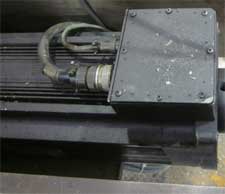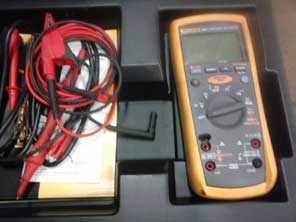Servomotor Troubleshooting Guide
This servomotor troubleshooting guide is provided with no warranty and is for entertainment purposes only. It is, however, considered a great place to start for a novice technician, maintenance person, or at-home troubleshooter.
Knowing your way around a servomotor is the first step in effective troubleshooting.
Servomotors are tested very much like standard three phase motors. We will explore similarities and differences as well as a step by step process to determine the status of most servomotors.
There is more converstion on this topic in our servomotor maintenance forum.
Basic Servomotor Operation
Stepper motors and servomotors have some similarities and many differences. In general, stepper motors are controllable in steps without feedback whereas servomotors require a feedback device to make adjustments accordingly.
Troubleshooting these two staples of industrial machinery is not all that complex when you have a basic understanding of electricity and some proficiency using a multimeter.
 A general familiarity with motors and their operation and design is an added advantage as well.
A general familiarity with motors and their operation and design is an added advantage as well.
Stepper motors and servomotors can be found in virtually every industrial environment these days. The complexity of industrial machines and the modern controls that make them so efficient usually feature a servomotor or stepper for some type of motion control.
Mechanical ratchets and gears, as well as human guided movement have long been replaced by these precision motors. A fully functional servomotor can do the work of many men, and do it with incredible accuracy.
The following article is a nice summary of Servomotor troubleshooting...
Typical Servomotor Problems
Before beginning any troubleshooting of industrial equipment, the maintenance personnel or the individual responsible for troubleshooting and repair should take all steps required to ensure his or her own safety and the safety of those in the area of the machinery. Proper lockout, tagout, and verification that the machine is energy-free is the responsibility of everyone involved in the troubleshooting.
After all shutdown procedures are complete, just go over and attempt to start the machine as an operator normally would. Personally, I consider this the last step before putting myself or other maintenance personnel in a position where motion can occur without warning.
First we need to remember that the motor is just one part of a motion control system. Once you have verified that the rest of the system is functioning normally, you can then proceed to determine if the motor has failed using a few simple tests. These test can be performed using a standard multimeter or a megohmmeter if one is available.
First, disconnect the motor cable at the drive. Also unplug any control connector or feedback cables at the drive or controller as well. This totally removes the motor from the control system and protects it during this step, the insulation test. I actually meter and then megger if necessary, the wires leading to the motor before I disconnect at the motor, but if the readings are not favorable we will actually go straight to the servomotor for this step.
Disconnect and label the motor cable at the motor junction box. Each wire on the motor can then be checked for continuity to ground using a standard ohmmeter. Each wire should read infinite or at least 100,000 ohms at a minimum, anything below that reading or a direct short to ground would indicate a failed winding.
 A general familiarity with motors and their operation and design is an added advantage as well.
A general familiarity with motors and their operation and design is an added advantage as well.
Be sure to make a good clean connection on both the motor wire and ground lug or case of the motor. Repeat this test with a megohmmeter (commonly called the megger) is one is available. Remember, performing this test at the drive also tests the wiring leading to the servomotor.
It is not uncommon to find crushed or broken wires leading to a servomotor, this costs far less to repair, and most technicians or maintenance personnel would be happy to find a crushed wire issue.
Next we will move to servomotor winding continuity. To check for continuity between the windings, you will need to set your ohmmeter to its lowest scale. There should be continuity between all three combinations of wires (T1 & T2, T1 & T3, T2 & T3) that reads in the area of 0.3 to 2 ohms.
A reading of 0.0 ohms would indicate a short circuit and and infinite or a reading of at least 1000 ohms would indicate an open winding, hence a failed servomotor.
Servomotors with brushes can be visually checked and the commutators cleaned when necessary. Brush dust can be carefully blown out of a dirty motor using compressed air. This may even help alleviate a resistance reading to ground during the short test.
Overall, the basics of servomotors and stepper motors are much the same as a standard motors. There are cases that I have seen where the servomotor label dictates a stark warning about winding damage due to high voltage from meggers, in this instance the megger insulation test must be bypassed.
Testing is also similar yet the name servo or stepper can sometimes intimidate even a seasoned electrician or maintenance technician.
Classifieds
We also offer free industrial classified ad system complete with a category designed for want ads. We strongly encourage those with individual parts for sale, specifically new or vintage Servomotors, to list them at OI. Ad creation takes only a few minutes and is free of charge.
Those requiring an odd-ball part or obsolete component can place a want ad just as easily, again, with no fees associated with ads. The OI ad system is at your disposal... Place a want ad, list your individual parts for sale, or post a listing for your company here.
Search Classifieds →About Us
We are a technology based organization. All information regarding Servomotors and their troubleshooting has been contributed by a community of industrialists. We do not warehouse parts and components, but provide a means for perspective buyers and sellers to achieve their goals.
See also: PLC Hardware Troubleshooting Guide | Contactor Troubleshooting Guide
Automation, Electronics, & Industrial News
- How much per hour? Here's a cool salary wizard Free to use, search for industrial technician salary info near you. What are your salary expectations? Whether you are researching a new job offer, looking for a promotion, or just want to see what you should be getting paid as a technician.
- A Troubleshooter or Repairman... What is a Maintenance Technician? A maintenance technician will be involved in routine maintenance procedures as well as helping to troubleshoot problems should they arise with equipment in the manufacturing process, assisting in the installation of new manufacturing equipment, and calibration of equipment and routine inspection and testing of machinery. Read more...
- ABB launches IoT Dashboard IoT Dashboard for Commercial Building Automation ABB says its IoT Dashboard is "easy to commission, simple to install and intuitive to use", and allows better control, monitoring, and automation of any building functions.




